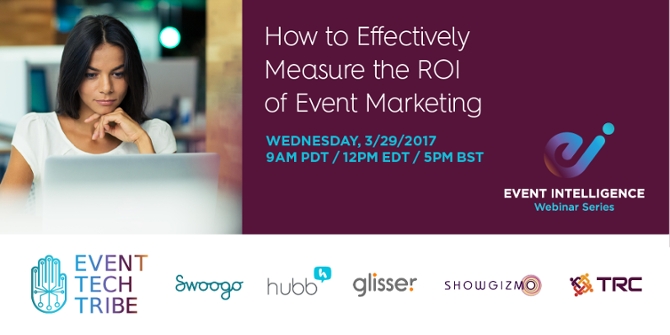One of the main challenges when calculating event return on investment (“Event ROI”) is attribution.
That is, “to what extent can we prove that this event directly led to this result?” The result might be a new client, an increase in business from an existing client, a change in behaviour within a workforce, or simply an increase in brand recognition.
Let’s take a real-life scenario: you have a marketing booth at a trade conference and scan the details of 400 delegates. Fifty of those delegates then watch your CEO’s presentation, and five of those delegates become new clients over the following 12 months.
The event led to the new business, right?
Wrong.
Your sales team indicate that they’ve already had numerous meetings with four of the new clients, and the last was someone they’d be leaving messages with for months. It’s all there on the CRM system as proof. They won the client, so you can’t claim it was the result of the marketing effort put into the conference.
So who’s right?
Well after the sales and marketing teams have had a heated debate, the outcome is usually that a combination of sales and marketing activities will have contributed to discovering and nurturing that prospective customer over the line. It’s rare, especially in B2B marketing with multiple decision makers, extensive decision making criteria, and long deal cycles, for any one action to be alone in contributing to the success.
Now we’re all friends again, how do we even start to calculate whether the ROI for the event was positive? Surely we need to know this if, as a marketing team, we’re going to make a decision on whether to do that event again next year, and how much to invest in it.
So should we say that the deal was 50% the result of marketing activity and 50% sales?
Or maybe 75% sales and 25% marketing, with 10% attributed to the event?
Now it’s getting complicated, and arbitrary.
So here’s the trick…
You don’t actually need to assign a specific attribution value to your events.
That’s right – breathe a sigh of relief. There’s absolutely no need to have any more sales and marketing attribution showdowns.
Instead, just use this template attribution calculator to review and compare multiple events, or even your entire event portfolio, on one single sheet.
So take a quick look, then we’ll explain how it works…
What data do I need to enter?
Going across the columns:
- The name of the event (and year if helpful for quick reference)
- The month and year of the event (for quick sorting)
- The number of attendees (or booth scans, for example)
- The event total cost (including staff travel and accommodation for a full picture)
- Nothing to enter here – this column just gives a useful figure of cost per attendee
- Number of ‘deals’ won in a given period* after the event (or whatever your primary objective is)
- Number of ‘new clients’ won in a given period* after the event (not required, but may be a useful secondary metric)
- Total deal value (or whatever ‘return’ you’d like to measure in your ROI)
This is just an example for an organization interested in generating new business revenues, with a secondary metric of generating that business from new customers at events. With this information, there are all sorts of additional calculations that could be made, but we’re just keeping it simple here.
The model can be adjusted for other metrics, or other measures of return. The point is that you’re clearly recording a cost attributed to the event, and some consistent score of the desired outcome, ideally with a financial value applied to that.
* There’s always the tricky question of timing – how long should you count deals, new clients, or other outcomes after the event, and still attribute them to the event’s influence. We’ll cover this later in the ‘limitations to the model’ section.
What data do I get out?
Now for the good bit. The model does not require you to attribute a set, pre-determined, or even arbitrary contribution to the event. Instead it outputs a contribution based upon a range of attribution percentages.
In other words, it models the amount of money the event has generated for a range of different percentage attributions.
In this case, we’ve set the lowest attribution value to 0.5%. That is, the event has only contributed a tiny fraction to the deals that followed.
We’ve then set the highest attribution value to 10%. In this column we’re assuming all the events provide about 10% of the influence over the new client deals that follow. This is still very conservative.
Then we model various options in between. You’re welcome to adjust these columns, adding as many as you like, for contributions ranging from zero to 100 per cent.
What does it show and why is it effective?
Using a quick colour scale, we can see which events break-even (i.e. deliver a positive event ROI) at the various contribution levels. So events that produce a positive ROI, even when they are considered to only be contributing a small percentage to winning the deal, are better than those that never produce a positive ROI, or do so at a higher contribution level.
What’s really powerful about this approach, is that it provides a simple comparison between multiple events using the same scale.
Let’s take the example:
- We can see that many events provide a positive event ROI at very low (3%) contribution levels – the Spring Roadshows in London, New York and Frankfurt; the second webinar; and the Fall Roadshows in London and New York.
- From this we can determine that the London, New York and Frankfurt Roadshow events are producing a better ROI than the equivalent Paris and Singapore events, despite higher attendee numbers in Singapore, for example.
- We can see the Cannes tradeshow produces a positive ROI at the highest contribution level, but the Barcelona tradeshow never gets there even at 10% contribution – should the Barcelona tradeshow be reviewed next year?
- We can see the webinars can have binary results – just one new client from them and they are usually effective.
- We can see the Gala events are not effective at delivering a positive ROI, by this measure (more on that later).
This is really just the start of the analysis, and additional information could be collected and added to make the data even more insightful.
For example, event feedback (through live polling onsite) could allow us to start applying delegate satisfaction score to the events, to see if there was a correlation between event ratings and subsequent new business.
And in a later post, we’ll also talk about how we can start analysing individual delegate metrics for an extensive contact-driven approach to event ROI.
Limitations to the model
A data-driven model like this can never cover all scenarios – especially when we’ve boiled down the analytics to something ultra-simple just to give a flavour of what can be done. So it’s really important we cover off some of the obvious limitations, so you can account for them when using it.
Here’s a list of the main ones – feel free to get in touch with other thoughts:
- It’s not clear how far into the future should you count the results from your event. For example, a new client could sign 18 months after attending, and have been influenced by the event. This really depends upon your typical sales cycle, and you should find a compromise period that gives you meaningful data – the important thing is to measure things consistently.
- New business is not the only measure. Correct – it’s relatively simple to calculate, since the data should be available, but you can get a lot more sophisticated. For example, just using incremental new business (i.e. if the client did £100,000 of business in the year before the event, and £150,000 in the year after the event, only count the £50,000 increase).
- It doesn’t measure the non-revenue objectives of the event. This is definitely the most important caveat to consider, since increasing sales revenues is just one of many reasons to run events. See my other blog post on different potential measures of ‘return’. In the example given on the spreadsheet, the Tradeshows might be as much about brand-building or ‘being seen to be there’ as for winning specific new business, or the Gala events might just be to thank existing clients. But this doesn’t mean that the model falls down – you have two options:
- Track the metrics which are important for that event (brand recall, client satisfaction, etc.) and add that data into the model.
- Score some events at a higher contribution level – in the example, Tradeshows could be seen to contribute 20 or 30 per cent to the deals being won because they might have a more powerful branding effect, compared to lower prestige events such as the webinars.
Ultimately, the model just gives you a quick visualisation from a limited data set, and from that you can start to interpret things in a meaningful way for your particular business.
We’d always recommend combining revenue metrics like this with delegate feedback metrics for a fuller picture – for more information on how you can collect better feedback and data at your events, and how technology can help you do that, click here.


